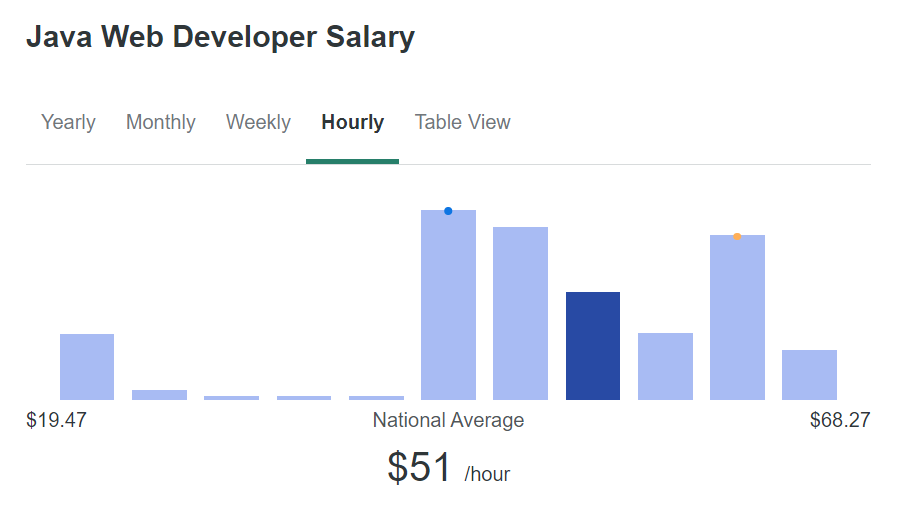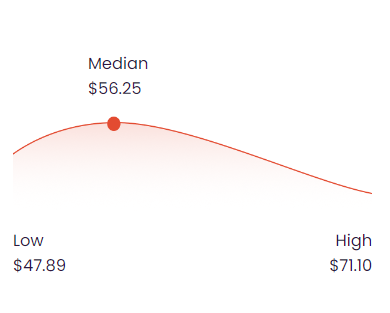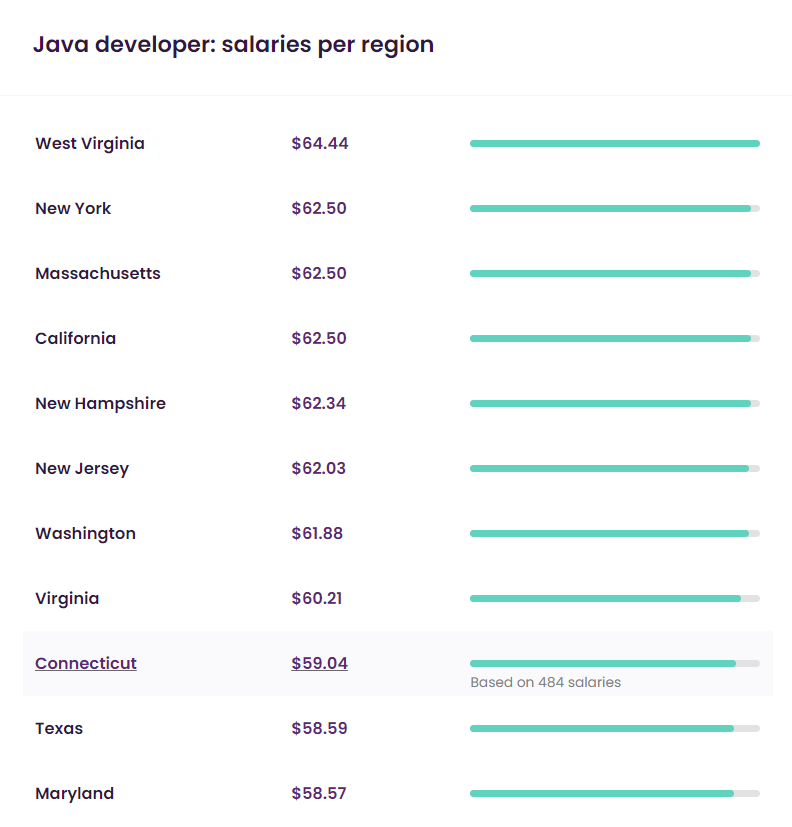A Comprehensive Guide to Java Developer Hourly Rates in 2023
In the United States, the typical annual salary for a Java developer averages $117,000, equivalent to an hourly rate of $56.25. Entry-level roles typically commence at $99,612 annually, while seasoned professionals in the field can earn as much as $147,892 per year.
Table of Contents
This blog post serves as your comprehensive guide on the hourly rate of Java developers, providing valuable insights to help you make informed decisions when you decide to hire a Java developer. With this knowledge, you can find a dedicated Java developer who not only aligns with your budget but also delivers the quality and expertise your project demands.
Factors Influencing Java Developer Hourly Rates
Several factors influence the hourly rates of Java developers. They include:
- Experience Level: The developer’s experience greatly impacts their rate. Junior developers with less than two years of experience command lower rates than mid-level or senior developers with a proven track record and several years of experience.
- Specialization: Developers with niche skills, like knowledge of certain frameworks (Spring, Hibernate), microservices, or enterprise solutions, may command a premium rate.
- Location: Geography plays a significant role in determining the hourly rate. Developers in countries with a high cost of living, such as the United States or Western European countries, typically charge higher rates compared to those in Eastern Europe or Asia.
- Project Complexity: Projects involving complex business logic, advanced integrations, or high scalability requirements might necessitate higher pay rates.
Java Developer Hourly Rates as Per Experience
- Junior Developers: A junior developer typically has less than two years of experience and limited exposure to complex projects.
- Mid-level Developers: These are developers with about two to five years of experience. They have worked on a fair number of projects and are adept at handling more responsibilities.
- Senior Developers: Senior developers have more than five years of experience and have often led projects or teams. They can analyze business needs, design software architecture, and handle project management.
| Experience | Average Hourly Rate |
|---|---|
| Junior Developers | $20 - $40 |
| Mid-level Developers | $40 - $70 |
| Senior Developers | $70 - $120 |
According to ZipRecruiter, the average hourly rate for a Java Developer in the United States stands at $56.13. This figure, however, fluctuates depending on location, experience, and proficiency, with the lower 25th percentile earning around $47.60 per hour, while those in the 75th percentile can expect to make approximately $62.98 an hour.
An Overview of Java Developer Hourly Rates by Region
| Region | Average Hourly Rate |
|---|---|
| North America | $60 - $120 |
| South America | $20 - $50 |
| Western Europe | $50 - $90 |
| Eastern Europe | $30 - $50 |
| Australia | $50 - $90 |
| Asia | $15 - $40 |
| Africa | $12 - $30 |
When comparing these rates, North America, Western Europe, and Australia stand out as the regions with the highest Java developer hourly rates. This trend aligns with the high cost of living in these areas and the high demand for experienced developers.
On the other hand, South America, Eastern Europe, Asia, and Africa offer competitive rates due to the lower cost of living. However, these regions still maintain a high quality of work, making them attractive for businesses seeking to optimize costs without sacrificing quality.
Statistics from talent.com suggest that even in the United States, the salary obtained by Java developers varies according to the state. The highest salary is obtained by developers in West Virginia followed by developers in New York, Massachusetts, California, New Hampshire, New Jersey, Washington, Virginia, Connecticut, and Texas coming in tenth place.
Further, talent.com details that in the United States, the average hourly rate for a Java developer is $56.25 per hour. Entry-level positions start at $47.89 per hour, while the most experienced workers can earn up to $71.10 per hour.
Java Developer Hourly Rates Based on Project Complexity
The complexity of the project significantly impacts the hourly rates for Java developers. Here’s a breakdown:
- Small-Scale Projects: These are projects with straightforward requirements, such as building a simple web application or modifying an existing one. They usually don’t require specialized skills or significant architectural decision-making.
- Medium-Scale Projects: These projects involve more complex requirements, potentially including integration with other systems, handling larger databases, or implementing more advanced features. Developers working on these projects need a good grasp of best practices and various Java frameworks.
- Large Enterprise-Level Projects: These projects are often complex, involving a high level of scalability, security, and integration with multiple systems. They also usually require strong architectural design and potentially leading a team of developers.
| Project Scale | Average Hourly Rate |
|---|---|
| Small-Scale Projects | $20 - $50 |
| Medium-Scale Projects | $40 - $80 |
| Large Enterprise-Level Projects | $70 - $120 |
Small-scale projects tend to have lower rates due to their straightforward nature and lower complexity. Medium-scale projects carry moderate rates, reflecting the added complexity and the need for a deeper understanding of Java and its associated tools and frameworks. Large enterprise-level projects attract the highest rates due to the high level of expertise and leadership abilities required.
The more complex a project, the higher the developer’s hourly rate. It’s essential for businesses to understand this to budget effectively and set realistic expectations for their projects. Beyond the hourly rate, considerations such as the developer’s experience, past projects, and reviews should also be taken into account to ensure a successful collaboration and project outcome.
An Industry-Wise Breakdown of Java Developer Hourly Rates
The data outlines how the hourly rate for Java developers varies across different industries. Finance leads the pack, likely due to the high complexity and security demands in the industry’s Java-based solutions. Manufacturing is a close second, reflecting its rising reliance on digital systems for operational efficiency.
Interestingly, the technology sector, despite being central to software development, comes in third, potentially due to the diverse range of projects and roles it encompasses. The insurance and telecommunication industries follow with similar rates, regarding Java’s important role in crafting secure, efficient solutions in these sectors.
Lastly, the professional services sector has the lowest average rate, possibly due to the wide range of project complexities and requirements in this industry. These trends underscore the differing demand, industry-specific challenges, and project complexities that influence the average hourly rates for Java developers across sectors.
| Industry | Average Hourly Rate |
|---|---|
| Finance | $46.56 |
| Manufacturing | $44.63 |
| Technology | $43.78 |
| Insurance | $42.47 |
| Telecommunication | $41.95 |
| Professional | $40.73 |
How Specialization Affects Java Developers’ Hourly Rate
The proficiency in certain Java-related technologies or frameworks can significantly influence a Java developer’s hourly rate. Here are a few notable examples:
| Framework / Technology | Average Hourly Rate |
|---|---|
| Spring Framework | $50 to $100 |
| Hibernate | $45 and $90 |
| Microservices with Spring Boot | $60 and $120 |
| JavaFX | $40 to $80 |
| Android Development (Java) | $30 and $70 |
| Machine Learning with Java | $70 and $120 |
Developers with specialized skills, especially in high-demand areas like microservices with Spring Boot or Machine Learning, can command higher rates. This reflects the increasing value of these specializations in today’s digital transformation era, where advanced and efficient solutions are highly valued.
On the other hand, more conventional skills like Android Development or JavaFX tend to have lower hourly rates, although they remain crucial in their respective domains.
A Java developer’s specialization significantly influences their hourly rate. This highlights the importance for developers of continuous learning and skill enhancement in areas of growing demand and technological advancement. Likewise, it’s essential for organizations to be aware of these rates when budgeting for Java development projects.
Conclusion
This blog post provides an insightful look into the annual earnings for developers who specialize in Java. It underscores the influence of factors such as experience, geographic location, and industry demand on salary levels. This guide is essential for Java developers seeking to understand their financial prospects and for employers aiming to offer competitive and fair compensation in the robust and diverse field of Java development.
You can check out our Java Developer Annual Salary Guide to learn about the annual salary rates you can earn in the US and across the world. We bring you a complete Java Developer Hiring Guide along with the Java Developer Job Description and Java Interview Questions guide which will help you in the process of hiring a Java developer in 2023.
Table of Contents











